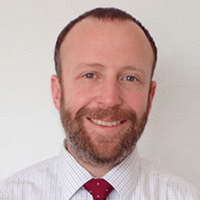|
OD learns not only what his KPIs mean but also how he can impact them through SNAPP MasterMinds program
As a relative newcomer to Pearle Vision, Anthony Perry, OD, says that being able to learn from businesspeople who have travelled the same road is extremely helpful. Dr. Perry began the franchise process in 2013 by converting a corporate location in Nashville, Tennessee, to a franchise. Three years later, in August 2016, he opened a new Pearle Vision Eye Care Center in Clarksville, Tennessee. “Both had their challenges, but the corporate conversion already had patients and a cash flow. In comparison, a cold start can be brutal for a while,” he says.

Dr. Perry
That’s when he knew he needed input on the business side. He joined a group called ProfitMastery, an organization that helps business owners in various industries dive deeper into the understanding of revenue, profitability and expenses. So when he heard that SNAPP was starting a SnappGroupMasterminds study group, he signed up. “In optometry school, we didn’t learn the business aspects. We were taught how to take care of patients, but we didn’t learn how to take care of ourselves and our businesses. From an analytical perspective, I was a little lost.”
SnappGroupMasterminds has been meeting virtually and will meet in person during Optometry’s Meeting in Chicago in June for some intensive discussions. “This group holds me accountable for the key productivity indicators (KPIs) that I should be measuring,” he says. He appreciates the perspectives his colleagues bring; even though group members are from all over the country, they share the experience of being in a Pearle Vision setting.
Dr. Perry says that he learned he had been making some smart decisions; many of his KPIs were in a solid range. “I knew that I needed to measure these, but I didn’t know how to evaluate them or how to measure the impact of changes. I happened to be on the correct path, so it’s great to be lucky. But I also want to be smart,” he says.
One business adage says that “what you measure, improves.” Simply the act of watching a metric and monitoring when it goes up or down brings more attention to that KPI. But now he knows more about why these statistics are important and how he can exact more control.
Dr. Perry encourages other Licensed Operators to enroll in the next SnappGroupMasterminds event. Mining the data from a practice management system carries a bit of a learning curve, but it does eventually become second nature. “If you are interested in learning how to service your investment in your business and yourself better and are willing to get out of your comfort zone, the time commitment is absolutely worthwhile,” he says.
|







